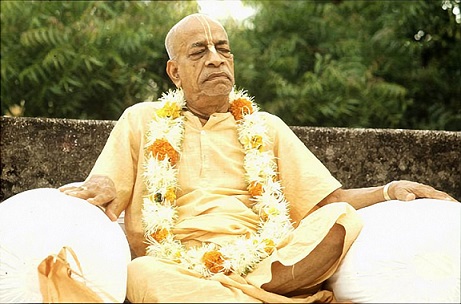
With so much bloodshed happening all over the world, one wonders if there can be any end to this crisis
tasya sanjanayan harsam
kuru-vrddhah pitamahah
simha-nadam vinadyoccaih
sankham dadhmau pratapavan
“Then Bhisma , the great valiant grandsire of the Kuru dynasty, the grandfather of the fighters, blew his conchshell very loudly like the sound of a lion, giving Duryodhana joy.” – Gita 1.12
Duryodhana doubted, “My grandfather, Bhisma , is more affectionately inclined to the other party. So he may not be lenient in fighting.” Tasya saijanayan harsam: “In order to encourage Duryodhana.” Bhisma wanted to say, “Don’t think that I am lenient. I am strong.” Immediately, to encourage him, he blew his conchshell. Nowadays they use bugle. Formerly the conchshells were used by the kings.
And it was not like the fight that happens in modern days – the poor soldiers come to fight, and the leaders remain in a safe place. All ksatriyas came out. Bhisma deva came, Duryodhana came, Arjuna came. And face to face, they had to fight. Not that the poor soldiers would fight and they would remain in a secure place, no.
Bhisma was kuru-vaddha, the oldest man in the Kuru dynasty, or pitamaha, the grandfather of Arjuna and Duryodhana. He was Dhatarastra’s elder uncle, his father’s elder brother. He was very old, a brahmacari, and in that old age, he was taking the risk of fighting. This is ksatriya spirit. Dhatarastra was blind, physically unfit to fight, therefore he did not come to the battlefield. Bhisma deva, despite his old age, came to fight. This is ksatriya spirit. When there is fight, there is no rest. And fight means “Either the other party or I shall be killed.” The fighting will not stop without a decision. When there are two belligerent parties, one party has to win. “Either you kill me or I kill you.”
In the fight between Jarasandha and Bhima, the fight happened during the day, and at night Jarasandha treated Bhima as his guest with respect. They fought for twenty-eight days, but no decision came out. Then Krishna gave a hint to Bhimasena: “Jarasandha has got a defect. His body is formed by joining two parts. So if you bifurcate him, then he will be killed.” So Bhimasena took this advice and killed Jarasandha.
So in ksatriya warfare, unless one party is killed, the fighting cannot stop. In the Battle of Kuruksetra, all the kings were determined to fight till the end. This is another qualification of a ksatriya: not to go away from the fight. When there is challenge of fighting, a ksatriya would immediately accept. That is ksatriya spirit. isvara-bhavam ca: and ruling over others. And charitable. These are the symptoms of ksatriya.
These qualifications are described in the Bhagavad-gita: brahmana qualification, ksatriya qualification, vaicya qualification, cudra qualification. It was a very nice arrangement of the Vedic civilization. Everyone is guided by the superior. The brahmana guides the ksatriyas, the ksatriya guides the vaicyas, and the vaicya employs the cudras. Catur-varnyam maya sastam guna-karma-vibhagaca [Gita 4.13]. In this way, the four divisions of brahmana, ksatriya, vaisya, and sudra manage the whole society nicely. The ksatriya’s business was to give protection to the citizens, and vaicya’s duty was to give protection to the animals. Kasi-go-raksya-vanijyaà vaicyakarma svabhava-jam [Gita 18.44].
Vaicyas should engage in agricultural production and in giving protection to the cows. This is specifically mentioned – goraksya. Go-raksya, or cow protection, is one of the items of state affairs. And now there is no cow protection. Poor cows – they deliver milk, and later they are slaughtered. How sinful the modern society is, and they still want peace and prosperity. That is not possible. The society must be divided – brahmana, ksatriya, vaicya, cudra – and they must execute their proper duty. And the vaicyas should give protection to the cows. And the cudras should work under the direction of the higher three divisions. In this way there will be nice management.
During the reign of Maharaja Yudhisthira, material nature worked perfectly. Kamaa vavarsa parjanyah: “the clouds showered all the water that people needed” [Bhagavatam 1.10.4]. If you keep things all right, according to the direction, then nature also will help you. Nature will give you sufficient foodstuff and all the necessities of life by supplying timely rains, or vasdi. Now the whole world is suffering due to drought. There is scarcity of rain. And if the rain does not fall for one or two years more, there will be havoc. It has already started. In India there is famine, because they are mostly agriculturists. In other countries they have got industries. But India is not so industrially advanced. So without water, nothing can be produced.
Yajiad bhavati parjanyau [Gita 3.14]. If you want sufficient water, then you must perform yajna, or sacrifice. These are the directions of the Vedic wisdom. At the present moment no other yajna is possible except sankirtana-yajna. Yajnaiu sankirtana-prayair yajanti hi sumedhasau [Bhagavatam 11.5.32]. So if this Krishna consciousness movement is taken seriously all over the world and they perform sankirtana-yajna, everything will be adjusted immediately. But these rascals will not take it. They will suffer. Otherwise all directions are there. People have to take advantage of the perfect direction, without any mistake, and they will be happy. So we are trying to introduce this Krishna consciousness movement so that people may come to their senses, take advantage of it and be happy.
Thank you very much. Hare Krishna .
